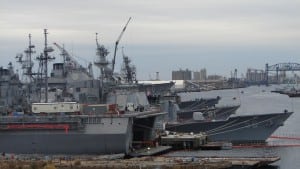The Navy’s top shipbuilding officials recently said a new private shipyard investment plan will “mirror” the currently underway Shipyard Infrastructure Optimization Plan (SIOP).
The Navy’s first naval vessel long-range plan for maintenance and modernization plan was released with the Fiscal Year 2020 budget request in March. While the document highlighted the need for more dry docks and is developing a plan for more, it said the Navy is working on a Private Shipyard Optimization (PSO) plan (Defense Daily, March 22).

The Navy expects the PSO results to be released with the FY 2021 budget request documents.
“So it’s going to mirror the SIOP plan and we’ve gone out and worked very closely with industry and basically did the same thing we did with the public yards. We went out to each of the private yards and said what would you need in terms of investments to be more successful,” Vice Adm. Thomas Moore told reporters at a roundtable on Friday.
He said the service will look at dry dock capacity, capital expenditures, and more.
Moore underscored the goal is to do the same thing with the private sector that the Navy is doing with the public sector “ and to get industry to really be engaged and want to do that from a business perspective.”
However, he said executing the strategy will inherently be different from the SOIP because these are individual private companies and not the public sector, where the Navy owns everything and can just put a budget together.
“We’re working with the Secretary to come up with some creative ways for how we can co-execute this. For instance, we could do it like we do a Small Bus Innovative Research. The Navy would have a pool of money and if industry came to us with a good idea in their yard, maybe we can self-fund some of it, like we do at CAPEX [Capital Expenditures] with the big yards.”
The Navy could also then incentivize companies to make investments in the yards, with the government providing seed money “and then they would go off and actually execute from there.”
James Geurts, assistant secretary of the Navy for Research, Development, and Acquisition, said he thinks of this concept as building on the SIOP as the service explores “how do we maximize the efficiency and effectiveness of the infrastructure we have, in this case on the private side.”
That also includes looking at reducing checkpoints for private industry work and looking at other secondary markets to open up to possible Navy maintenance work.
“So Admiral Moore’s looked and done a survey of where are there drydocks around the country. Should we go certify those in advance, so we may invest in sending folks out to certify a drydock even though it doesn’t currently have a Navy contract?” Geurts asked.
For example, Philly Shipyard, part of the Norwegian Aker ASA company, “is now doing maintenance work, I think, for the first time we’ve done that in a long time,” Geurts added.
He said given a constrained resource environment of drydocks and shipyard workers, “you’ve got to make sure you’re as efficient as you can and then you want to look for opportunities to as rapidly as possible open up more capacity.”
Geurts underscored Congress has “done some great support for us on pilot programs.”
Now, his overall plan is to go back to Congress with the FY 2021 request and wrap all they have worked on into looking at the next steps. The service will look at where it can work with private industry to “get us to the next step in terms of performance and affordability.”